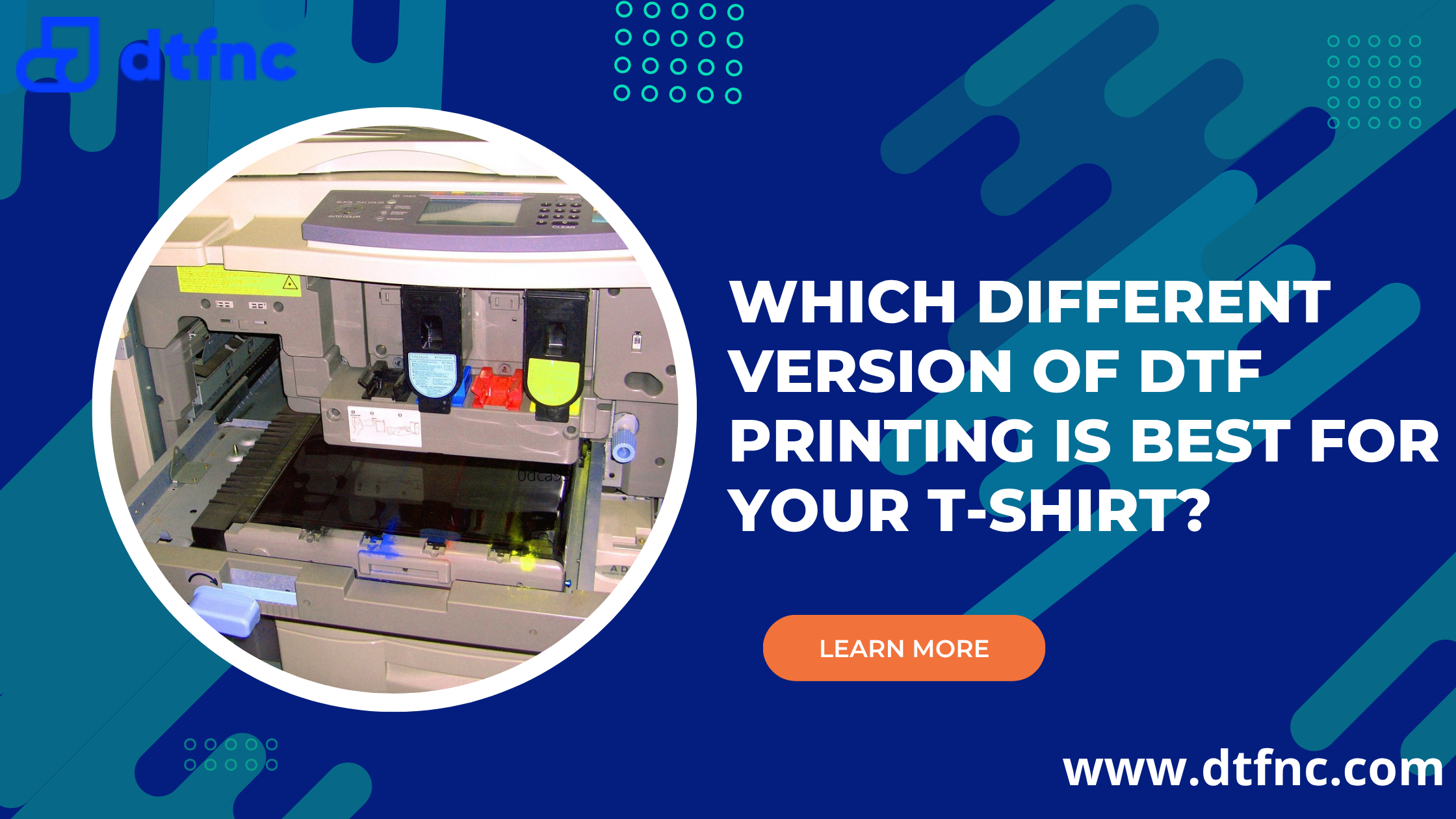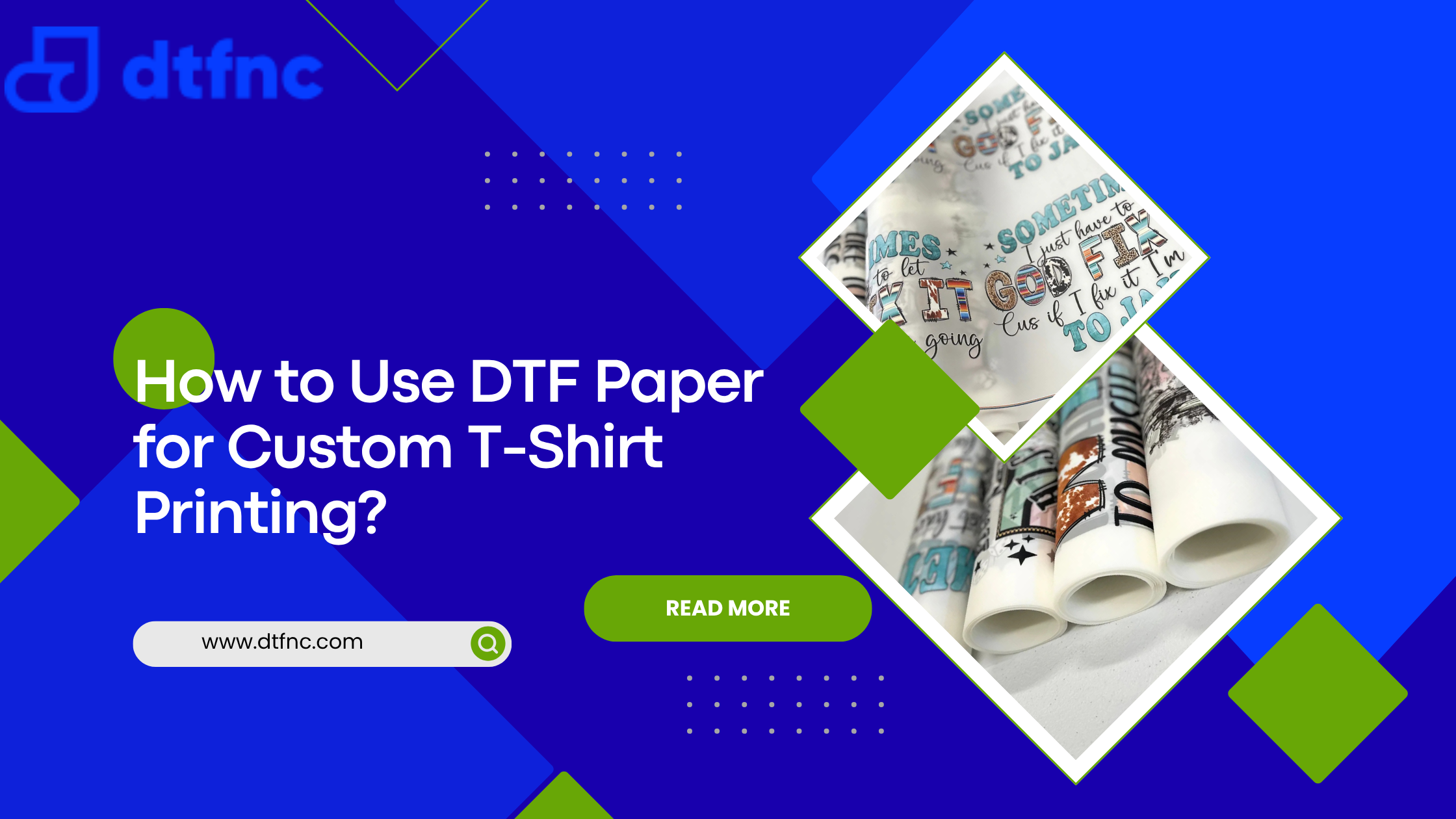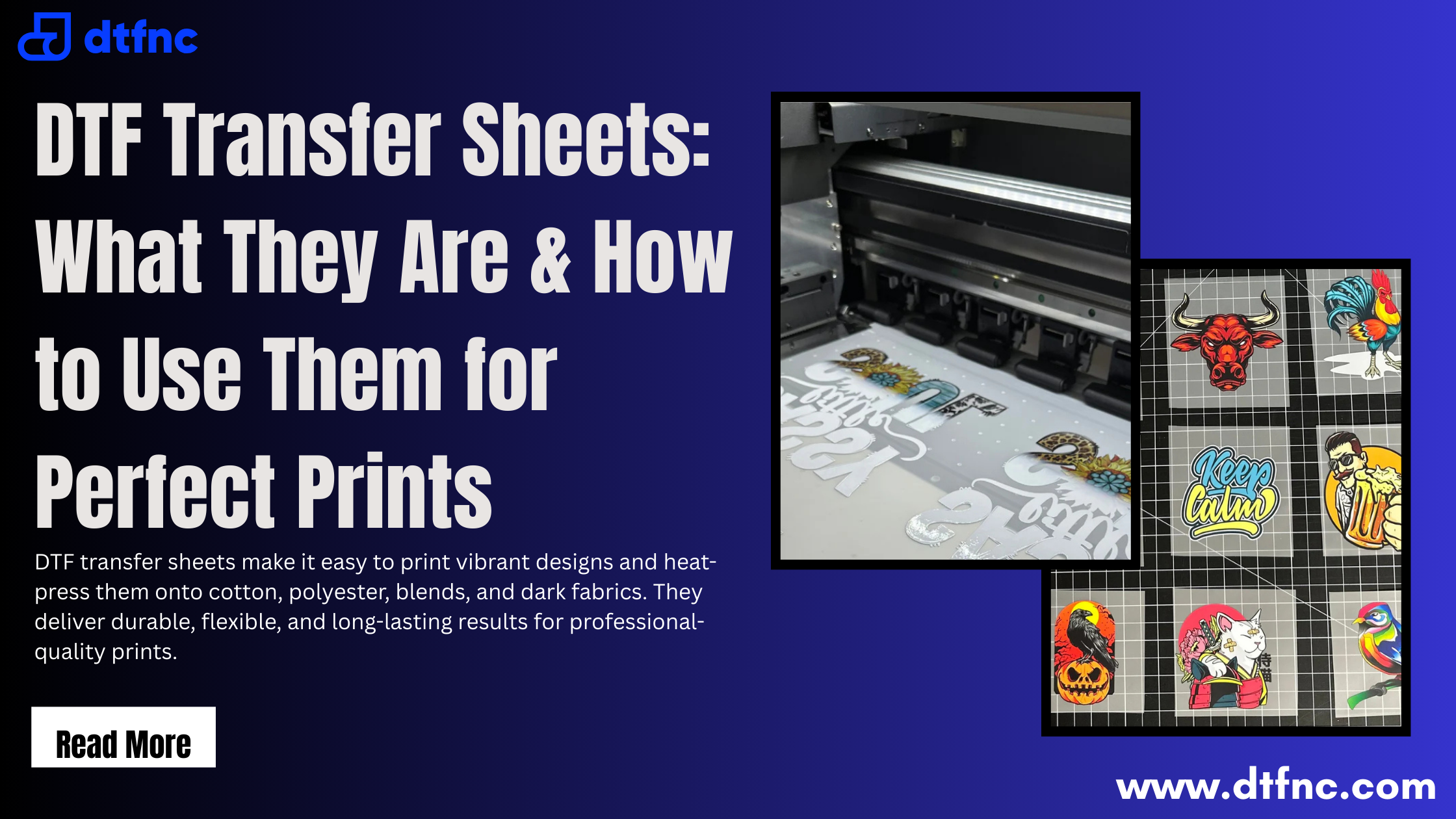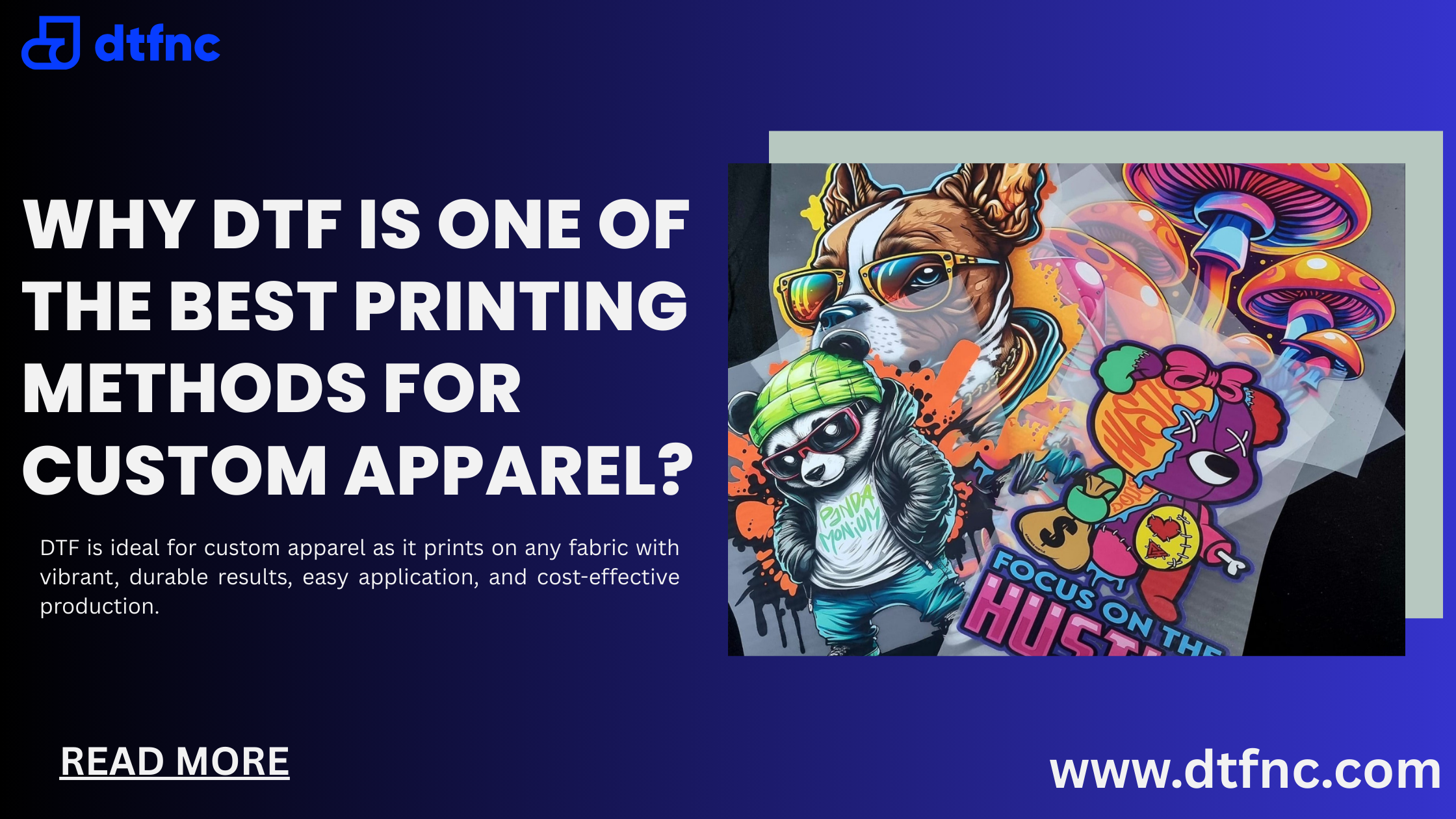Direct to Film (DTF) printing has gained significant popularity in the world of custom apparel and fabric printing due to its versatility and high-quality results. However, like any printing technology, DTF is not without its challenges.
Most Common DTF Printing Problems and Solutions
Direct to Film (DTF) printing has gained significant popularity in the world of custom apparel and fabric printing due to its versatility and high-quality results. However, like any printing technology, DTF is not without its challenges. In this blog post, we will explore the most common DTF printing problems and provide practical solutions to help you overcome these issues and achieve optimal printing results.
DTF Printing Problem #1: Ink Smudging

Problem:
One of the prevalent issues in DTF printing is ink smudging, which can ruin the quality of your prints. This problem often occurs when the ink is not drying properly or when excessive ink is applied.
Solution:
To solve this problem, ensure that you are using the right ink for your printer and fabric type. Additionally, check and adjust the curing settings on your printer to ensure proper drying.
DTF Printing Problem #2: Image Blurring
Problem:
Image blurring can result from various factors, such as printhead misalignment, low resolution images, or incorrect printing speed.
Solution:
To address this problem, calibrate your printhead regularly, use high-resolution images, and adjust the printing speed to match the specifications of your printer.
DTF Printing Problem #3: Color Inconsistencies

Problem:
Inconsistent colors can be frustrating, especially when working on projects that demand precise color matching.
Solution:
To resolve this issue, calibrate your printer regularly, use color management tools, and ensure that your software settings are configured correctly. Additionally, check for any clogs in the ink lines that might be affecting color distribution.
DTF Printing Problem #4: Film Wrinkling
Problem:
Film wrinkling during the printing process can lead to misalignment and poor print quality.
Solution:
To prevent this issue, make sure that your film is properly loaded and that the tension is adjusted correctly. Avoid overstretching the film, as this can cause wrinkles during printing.
DTF Printing Problem #5: Poor Adhesion

Problem:
Poor adhesion of the film to the fabric can result in peeling and reduced durability of the print.
Solution:
Ensure that you are using the right adhesive for your specific fabric type. Additionally, check the curing settings on your printer to optimize adhesion during the printing process.
DTF Printing Problem #6: White Ink Issues
Problem:
White ink plays a crucial role in DTF printing, especially on dark fabrics. Issues such as uneven coverage and clogging of white ink channels can occur.
Solution:
To address these problems, regularly agitate and circulate white ink in the system. Ensure that the white ink channels are clean and free from any obstructions.
DTF Printing Problem #7: Clogging of Printer Heads
Problem:
Printer head clogs can disrupt the printing process and result in inconsistent prints.
Solution:
Regular maintenance, including cleaning the printheads and using appropriate cleaning solutions, can prevent clogging. Additionally, avoid using expired or low-quality inks that may contribute to printhead issues.
DTF Printing Problem #8: Printhead Strikes

Problem:
Printhead strikes can cause damage to both the printhead and the substrate.
Solution:
Check for any obstructions on the printing bed, ensure proper media placement, and adjust the printhead height to avoid strikes. Regularly clean the printhead to prevent the buildup of debris that can lead to strikes.
DTF Printing Problem #9: Film Not Transferring Properly
Problem:
If the film is not transferring correctly to the fabric, it can result in incomplete prints.
Solution:
Check the temperature and pressure settings on your heat press, ensuring that they align with the recommended specifications for your DTF film and fabric. Experiment with different settings to find the optimal conditions for proper film transfer.
Also Read: How to Press DTF Transfers on T-shirts
DTF Printing Problem #10: Image Distortion
Problem:
Image distortion can occur due to issues with the film, such as stretching or misalignment.
Solution:
Ensure that the film is loaded correctly and that the tension is balanced. Additionally, check for any abnormalities in the printing process, such as sudden speed changes or printhead malfunctions, which can contribute to image distortion.

DTF Printing Problem #11: Film Peeling Off
Problem:
Film peeling off after printing can be a result of poor adhesion or incorrect curing settings.
Solution:
Double-check the curing temperature and time to ensure proper bonding between the film and fabric. Experiment with different curing conditions to find the optimal settings for preventing film peeling.
Conclusion
While DTF printing offers a powerful solution for custom apparel and fabric printing, addressing common printing problems is essential to achieve consistent and high-quality results.
Regular maintenance, proper calibration, and adherence to recommended settings are crucial steps in overcoming these challenges. By understanding and implementing solutions to these common problems, you can enhance your DTF printing experience and ensure successful and vibrant prints.
FAQs
Q: What are the problems with DTF printer?
A: Common problems with DTF printers include ink smudging, image blurring, color inconsistencies, film wrinkling, poor adhesion, white ink issues, printhead clogs, printhead strikes, film not transferring properly, image distortion, and film peeling off.
Q: Why is my DTF ink not coming out?
A: DTF ink may not be coming out due to clogged printheads, improper ink settings, or using expired or low-quality ink. Regular maintenance, proper ink circulation, and using high-quality ink can help resolve this issue.
Q: What causes spots on DTF transfers?
A: Spots on DTF transfers can be caused by printhead issues, such as clogs or misalignment. Regular printhead maintenance and ensuring proper printing conditions can help eliminate spots on DTF transfers.
Q: What are the disadvantages of DTF printing?
A: Disadvantages of DTF printing include the need for specialized equipment, occasional maintenance requirements, and potential challenges in achieving color accuracy on certain fabrics. However, with proper care and troubleshooting, these disadvantages can be mitigated.
Q: Why are my DTF transfers not sticking to my shirt?
A: DTF transfers may not stick to the shirt due to poor adhesion, incorrect curing settings, or using the wrong adhesive for the fabric type. Adjusting the curing conditions and ensuring proper adhesive selection can help improve adhesion and bonding.










8097 comments
Juniorintak
https://telegra.ph/Evaluaci%C3%B3n-de-clima-laboral-en-ONGs-chilenas-entre-la-vocaci%C3%B3n-y-el-desgaste-09-20
Visualiza esta postal frecuente en una oficina chilena: equipos desmotivados, cambio elevada, frases en el pasillo como a nadie le importa o puro agotamiento. Suena reconocible, ¿cierto?
Muchas pymes en Chile se pierden con los KPI y los resultados financieros, pero se olvidan del barómetro interno: su equipo. La advertencia incómoda es esta: si no revisas el clima, al final no te quejís cuando la salida de talento te golpee en la cara.
¿Por qué importa tanto esto en Chile?
El contexto local no da tregua. Vivimos fuerte rotación en retail, estrés extremo en los call centers y brechas generacionales enormes en industrias como la minería y la banca.
En Chile, donde domina la cultura de la talla y la cordialidad, es fácil tapar los problemas. Pero cuando no hay apoyo real, ese sarcasmo se transforma en puro relleno que camufla la desmotivación. Sin un análisis, las pymes son inconscientes. No ven lo que los empleados de verdad critican en la sala común o en sus chats internos.
Los ventajas palpables (y muy locales) de hacerlo bien
Hacer un análisis de clima no es un gasto, es la mejor decisión en rendimiento y paz mental que consigues hacer. Los beneficios son claros:
Menos licencias médicas y faltas: un lastre que le cuesta millones a las empresas chilenas cada periodo.
Permanencia de talento nuevo: las gen Z se mueven rápido si no perciben valor y buen ambiente.
Mayor productividad en equipos remotos: clave para talento en regiones que a veces se sienten desconectados.
Una ventaja competitiva real: no es lo mismo decir “somos buena onda” que demostrarlo con métricas.
Cómo se hace en la práctica (sin quemarse)
No ocupas un área de RRHH costoso. Hoy, las soluciones son cercanas:
Formularios online anónimos: lo más usado en la nueva normalidad. La base es asegurar el resguardo identitario para que la gente hable sin temor.
Check-ins semanales: en vez de una encuesta larga cada 12 meses, haz una pregunta semanal corta por plataformas internas.
Reuniones pequeñas: la joya. Revelan lo que difícilmente saldría por correo: roces entre áreas, fricciones con liderazgos, procesos que nadie entiende.
Conversaciones 1:1 con equipos fuera de Santiago: su mirada suele quedar omitida. Una llamada puede detectar problemas de comunicación que no captarías en una encuesta.
El factor decisivo: el diagnóstico no puede ser un relleno. Tiene que traducirse en un programa real con hitos, encargados y fechas. Si no, es puro powerpoint.
Errores que en Chile se repiten (y matan el proceso)
Prometer cambios y no ejecutar: los colaboradores chilenos lo cachan al tiro; puro humo.
No blindar el confidencialidad: en ambientes muy autorregidas, el miedo a reacciones es real.
Importar encuestas genéricas: hay que customizar el lenguaje a la idiosincrasia chilena.
Medir una vez y olvidarse: el clima varía tras la salida de un líder clave; hay que medir de forma constante.
Juniorintak
https://trentondtjzp.blogocial.com/conseguir-mi-competencias-laborales-to-work-73051116
Hablar de competencias clave en el trabajo en el mercado chileno es critico para entender los cambios que hoy viven las companias. La automatizacion, la globalizacion y la Generacion Z estan cambiando que habilidades se valoran en el mundo laboral.
Top de las competencias laborales mas buscadas
Flexibilidad
Las organizaciones chilenos necesitan trabajadores capaces de adaptarse rapido a nuevos escenarios.
Comunicacion efectiva
No solo hablar, sino escuchar. En equipos remotos, esta habilidad es vital.
Capacidad analitica
Con datos por todos lados, las empresas valoran a quienes filtran antes de decidir.
Sinergia grupal
Mas alla del “buena onda”, es lograr coordinarse con personas de distintos rubros.
Liderazgo
Incluso en roles no directivos, se espera guiar y no solo controlar.
Habilidades digitales
Desde herramientas digitales hasta plataformas, lo digital es hoy una skill base.
Motivos para importan tanto las competencias laborales mas demandadas?
Porque son la distincion entre quedarse atras o crecer en tu carrera. En Chile, donde la rotacion laboral es alta, dominar estas competencias se traduce en ascensos.
Como desarrollar las competencias laborales mas buscadas
Cursos online.
Mentoria.
Experiencia practica.
Retroalimentacion constantes.
Las competencias laborales mas demandadas son el pasaporte para asegurar tu futuro laboral.
Juniorintak
https://holdensdlrw.alltdesign.com/conseguir-mi-selecci%C3%B3n-de-personal-to-work-55357633
La empresa de reclutamiento y selección es infinitamente más que publicar un aviso en portales. En nuestro país, contratar mal a una contratación puede costar caro en plata.
Por eso, cada vez más empresas acuden un consultora de selección de personal que ofrezca resultados confiables y minimice los riesgos.
Razones para confiar en una empresa de seleccion de personal?
Llegada a profesionales que no responden avisos tradicionales.
Técnicas estructuradas para filtrar competencias.
Agilidad en cubrir vacantes críticas.
Optimización de errores de contratación.
Ventajas de un buen apoyo en selección
Ingresos más alineados con la realidad interna.
Reducción de fuga de talento.
Equipos más cohesionados.
Imagen más competitiva.
Problemas comunes en la captación de talento en Chile
Basarse solo en intuición.
Ignorar pruebas técnicas.
Pasar por alto la dinámica de la compañía.
Apurar la elección por presión.
Cómo elegir una consultora de selección de personal
Exige casos de éxito.
Confirma que usen métodos objetivos.
Evalúa la experiencia en tu rubro.
Pregunta por ética.
Un partner en reclutamiento es una apuesta que marca la diferencia entre formar equipos fuertes o perder competitividad.
MebonykaleErype
Canadian pharcharmy [url=http://amoxicillinpharm.com/]buy amoxicillin without prescription[/url]
[url=http://supremesuppliersindia.com/]online pharmacy[/url]
[url=http://viagrahealthyman.com/]healthy man viagra[/url]
[url=http://canadianpharcharmy.com/]canadian pharcharmy[/url]
[url=http://onlinepharmacywithoutaprescription.online/]usa pharmacy no script[/url]
[url=http://skyapharmacy.com/]canadian pharmacy cialis[/url]
[url=http://pharmacynoprescription.com/]flovent no prescription online pharmacy[/url]
[url=http://canadapharmac.com/]amoxicillin no prescription needed[/url]
[url=https://usapharmacynoscript.com/]https://usapharmacynoscript.com[/url]
[url=http://woldwidewithoutaprescription.com/]canadian prescription pharmacy[/url]
[url=http://skyphar.com/]northwest pharmacy canada[/url]
[url=http://onlineviagraprescription.com/]the real viagra on line non perscripton[/url] Toradol online without prescription us
Ronaldrem
teens porno